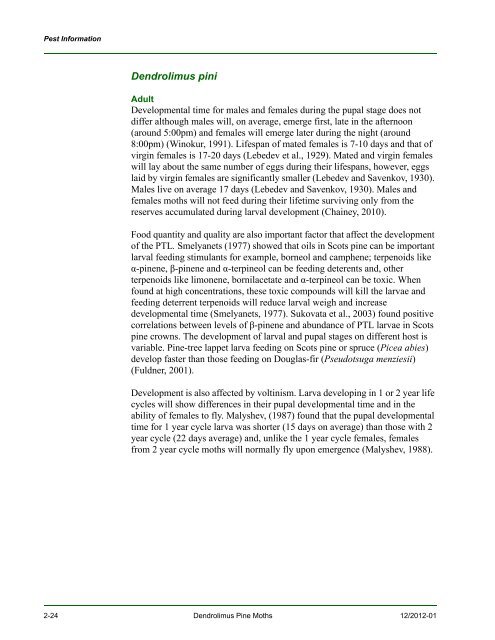New Pest Response Guidelines - aphis - US Department of Agriculture
New Pest Response Guidelines - aphis - US Department of Agriculture
New Pest Response Guidelines - aphis - US Department of Agriculture
Create successful ePaper yourself
Turn your PDF publications into a flip-book with our unique Google optimized e-Paper software.
<strong>Pest</strong> Information<br />
Dendrolimus pini<br />
Adult<br />
Developmental time for males and females during the pupal stage does not<br />
differ although males will, on average, emerge first, late in the afternoon<br />
(around 5:00pm) and females will emerge later during the night (around<br />
8:00pm) (Winokur, 1991). Lifespan <strong>of</strong> mated females is 7-10 days and that <strong>of</strong><br />
virgin females is 17-20 days (Lebedev et al., 1929). Mated and virgin females<br />
will lay about the same number <strong>of</strong> eggs during their lifespans, however, eggs<br />
laid by virgin females are significantly smaller (Lebedev and Savenkov, 1930).<br />
Males live on average 17 days (Lebedev and Savenkov, 1930). Males and<br />
females moths will not feed during their lifetime surviving only from the<br />
reserves accumulated during larval development (Chainey, 2010).<br />
Food quantity and quality are also important factor that affect the development<br />
<strong>of</strong> the PTL. Smelyanets (1977) showed that oils in Scots pine can be important<br />
larval feeding stimulants for example, borneol and camphene; terpenoids like<br />
α-pinene, β-pinene and α-terpineol can be feeding deterents and, other<br />
terpenoids like limonene, bornilacetate and α-terpineol can be toxic. When<br />
found at high concentrations, these toxic compounds will kill the larvae and<br />
feeding deterrent terpenoids will reduce larval weigh and increase<br />
developmental time (Smelyanets, 1977). Sukovata et al., 2003) found positive<br />
correlations between levels <strong>of</strong> β-pinene and abundance <strong>of</strong> PTL larvae in Scots<br />
pine crowns. The development <strong>of</strong> larval and pupal stages on different host is<br />
variable. Pine-tree lappet larva feeding on Scots pine or spruce (Picea abies)<br />
develop faster than those feeding on Douglas-fir (Pseudotsuga menziesii)<br />
(Fuldner, 2001).<br />
Development is also affected by voltinism. Larva developing in 1 or 2 year life<br />
cycles will show differences in their pupal developmental time and in the<br />
ability <strong>of</strong> females to fly. Malyshev, (1987) found that the pupal developmental<br />
time for 1 year cycle larva was shorter (15 days on average) than those with 2<br />
year cycle (22 days average) and, unlike the 1 year cycle females, females<br />
from 2 year cycle moths will normally fly upon emergence (Malyshev, 1988).<br />
2-24 Dendrolimus Pine Moths 12/2012-01

















